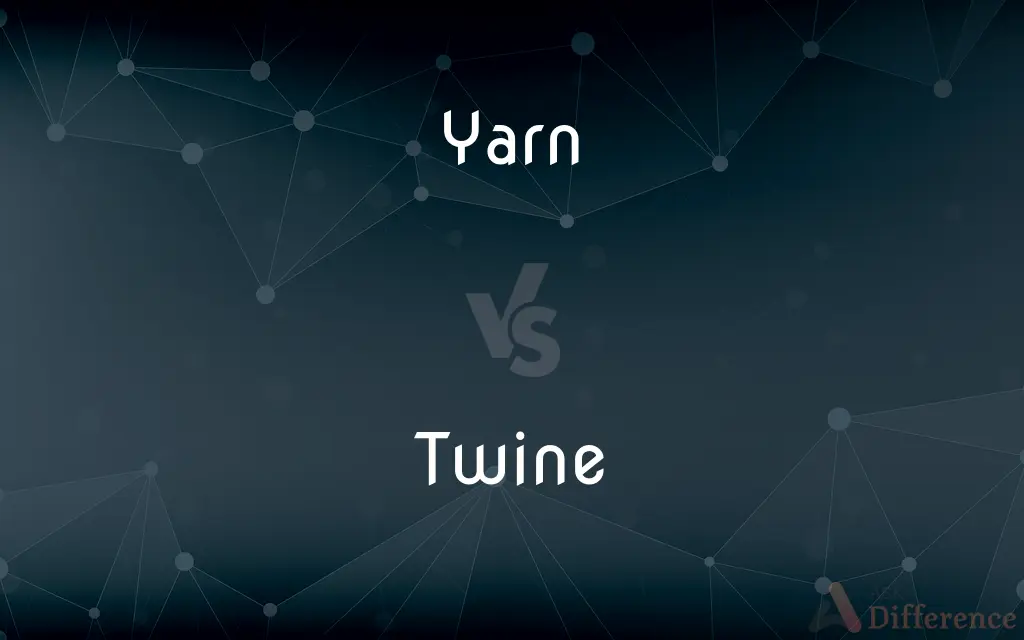Yarn vs. Twine — What's the Difference?
By Tayyaba Rehman & Urooj Arif — Updated on March 4, 2024
Yarn is a long, continuous length of interlocked fibers, used mainly in knitting and weaving, while twine is a strong thread or string composed of two or more smaller strands twisted together, often used for tying or binding.

Difference Between Yarn and Twine
Table of Contents
ADVERTISEMENT
Key Differences
Yarn is a fundamental material in the textile industry, designed for knitting, weaving, and crocheting to create fabrics or textile products. It is made from various natural or synthetic fibers, including wool, cotton, and polyester, spun into long, continuous lengths. Yarn can vary in thickness, texture, and color, making it versatile for different types of projects, from delicate lace to bulky sweaters. On the other hand, twine is specifically crafted for strength and durability, typically used in packaging, crafting, and gardening. Twine consists of multiple smaller strands of material—such as cotton, sisal, or jute—twisted together to form a strong, cohesive thread. Its primary purpose is not for creating fabrics but for binding, tying, and securing items.
While yarn is celebrated for its flexibility, color variety, and softness, making it ideal for garments and decorative items, twine is valued for its practicality and resistance to wear and tear. The twisting process in twine manufacturing enhances its tensile strength, making it suitable for applications that require durability and support. Conversely, yarn's structure aims to provide a balance between strength and flexibility, enabling the creation of textiles with varying textures and warmth.
The choice between yarn and twine depends on the project's requirements: yarn is preferred for textile creation, offering an array of aesthetic and tactile qualities, while twine is chosen for tasks that demand strength and binding capabilities. Despite their differences, both yarn and twine play crucial roles in their respective domains, from the creation of beautiful garments and household items to the practicalities of packaging and gardening.
Understanding the distinction between yarn and twine is essential for selecting the right material for a project. Yarn's vast range of colors and textures inspires creativity in knitting, weaving, and crocheting, whereas twine's strength and durability make it indispensable for packaging, binding, and other utilitarian purposes. Thus, the key difference lies in their intended use and construction, reflecting the diverse needs of crafters, artisans, and industries.
Comparison Chart
Definition
Long, continuous length of interlocked fibers
Strong thread composed of two or more strands twisted together
ADVERTISEMENT
Primary Use
Knitting, weaving, crocheting to create textiles
Tying, binding, packaging
Material
Wool, cotton, polyester, etc.
Cotton, sisal, jute, etc.
Texture
Varies from fine to bulky, soft to coarse
Generally coarse and strong
Strength
Designed for flexibility and texture in textiles
Designed for high tensile strength and durability
Color Variety
Wide range of colors for aesthetic purposes
Often natural or limited color range
Application
Garments, accessories, home décor
Gardening, crafts, packaging
Compare with Definitions
Yarn
Yarn is used in knitting to create fabrics.
She chose a soft wool yarn to knit her sweater.
Twine
Twine is often used in gardening and packaging.
She tied the tomato plants to stakes with garden twine.
Yarn
It is essential for creating textiles with texture.
The textured yarn added depth to the woven tapestry.
Twine
It is prized for its strength and durability.
The heavy-duty twine held the bundle of newspapers tightly.
Yarn
Yarn is available in a wide array of colors.
The yarn shop offered every color imaginable for crafters.
Twine
Twine is used for tying and binding.
He used twine to secure the package before shipping.
Yarn
It comes in various thicknesses for different projects.
Bulky yarn is perfect for a quick-knit scarf.
Twine
It is made by twisting smaller strands together.
The jute twine was strong enough for the garden trellis.
Yarn
Yarn can be made from natural or synthetic fibers.
Organic cotton yarn is preferred for baby clothes.
Twine
Twine comes in natural materials like sisal.
Sisal twine is biodegradable and environmentally friendly.
Yarn
Yarn is a long continuous length of interlocked fibres, suitable for use in the production of textiles, sewing, crocheting, knitting, weaving, embroidery, or ropemaking. Thread is a type of yarn intended for sewing by hand or machine.
Twine
Twine is a strong thread, light string or cord composed of two or more thinner strands twisted, and then twisted together (plied). The strands are plied in the opposite direction to that of their twist, which adds torsional strength to the cord and keeps it from unravelling.
Yarn
A continuous strand of twisted threads of natural or synthetic fibers, such as wool or nylon, used in weaving or knitting.
Twine
Strong thread or string consisting of two or more strands of hemp or cotton twisted together.
Yarn
Spun wool; woolen thread; also, thread of other material, as of cotton, flax, hemp, or silk; material spun and prepared for use in weaving, knitting, manufacturing sewing thread, or the like.
Twine
Make by twisting together or intertwining;
Twine a rope
Yarn
One of the threads of which the strands of a rope are composed.
Twine
Form into a spiral shape;
The cord is all twisted
Yarn
A fine cord of twisted fibers (of cotton or silk or wool or nylon etc.) used in sewing and weaving
Common Curiosities
Is twine suitable for knitting or crocheting?
Generally, twine is not suitable for knitting or crocheting because it is designed for strength rather than softness or flexibility.
Are there environmental considerations when choosing between yarn and twine?
Yes, the material composition and production process of both yarn and twine can have environmental impacts, making natural and biodegradable options preferable for eco-conscious choices.
Can yarn be used in place of twine for packaging?
While yarn can sometimes be used for light packaging, twine is preferred for its superior strength and durability.
How do the textures of yarn and twine compare?
Yarn textures vary widely, from soft and plush to coarse and rugged, while twine is generally coarse and more uniform, focusing on strength.
Is there a cost difference between yarn and twine?
The cost can vary based on the material quality and purpose, but generally, specialized yarns for crafting may be more expensive than basic twine used for utility purposes.
Can the color of twine be customized like yarn?
Twine typically has a limited color range, focusing on natural or neutral tones, unlike yarn, which is available in a wide spectrum of colors for creative projects.
Can yarn and twine be made from the same materials?
Yes, both can be made from similar materials like cotton, but their construction and end use differ significantly.
What is the main difference between yarn and twine?
Yarn is primarily used for creating textiles, while twine is used for tying, binding, and packaging due to its strength.
Can both yarn and twine be used in crafting?
Yes, both can be used in crafting, but their applications differ, with yarn being preferred for textiles and twine for projects requiring strength and binding.
How are yarn and twine produced?
Both are produced by spinning fibers or strands together, but yarn is often spun to create a softer, more flexible texture, while twine is twisted for strength and durability.
Share Your Discovery

Previous Comparison
Sad vs. Sorry
Next Comparison
Rogue vs. VagrantAuthor Spotlight
Written by
Tayyaba RehmanTayyaba Rehman is a distinguished writer, currently serving as a primary contributor to askdifference.com. As a researcher in semantics and etymology, Tayyaba's passion for the complexity of languages and their distinctions has found a perfect home on the platform. Tayyaba delves into the intricacies of language, distinguishing between commonly confused words and phrases, thereby providing clarity for readers worldwide.
Co-written by
Urooj ArifUrooj is a skilled content writer at Ask Difference, known for her exceptional ability to simplify complex topics into engaging and informative content. With a passion for research and a flair for clear, concise writing, she consistently delivers articles that resonate with our diverse audience.















































